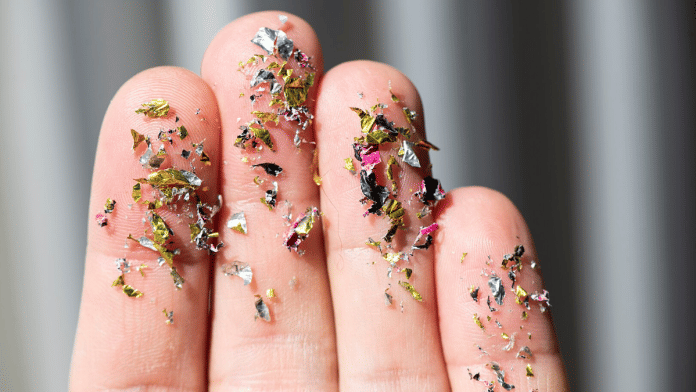Hello there, multi-routined skincare people — I’m talking to you “doing-it-for-the-glow” peeps. If you’ve got more than five steps in your skincare routine, here are my two cents for you.
Have you wondered what’s in those products that you use on your face every day? We’ve all heard of the main vamps in the world of skincare — sulphates and parabens — but of late, there has been another villain you need to be worried about. And they’re microplastics.
Today, almost every skincare and beauty product has some quantity of microplastics; plastics so tiny that even a jewellery maker would have a hard time detecting them. From scrubs to serums, face masks, lipsticks and makeup dipsticks — microplastics are everywhere. Here’s why it’s time to cancel these specific baddies from your skincare routines.
More plastic
Remember those birthday parties where glitter was everything? And then remember the scrubbing down your mother would have to give you to get rid of that glitter? And how, despite it all, you’d still show up the next day with specks of shine on you?
That’s microplastics in a nutshell. These tiny pieces of plastic are in almost every skincare product that brands push toward you. They’re easily responsible for a chunk of your skin drama. Brands add these tiny things into multiple products—fillers, texture enhancers, etc. That exfoliation cream with microbead-whatever is chockfull of these guys.
Who cares? ‘You’ should
These sneaky pieces don’t just go with a good wash. No, no – they stick around, clogging pores and bringing in their friends like skin irritants that cause inflammation. Trust me, once exposed to your skin, these sly things are actively chilling in your pores, having a pizza party of their own.
And if you’ve got sensitive skin, then microplastics might be making your skin (and life) much worse by triggering conditions like eczema and dermatitis.
Here’s what they do, specifically.
Irritate and inflame your skin: All microplastics found in your skincare products such as scrubs and face washes leave a tear. These little beads/plastic pieces invite redness, inflammation, and breakouts into your life. Take it from a dermatologist who’s been in the industry for more than 13 years — redness is not giving.
Block your pores: These plastics settle right between your pores, making an unholy mix of oil and bacteria that brings up everyone’s hated skin condition: acne.
Breaking barriers: Microplastics tear down your skin’s barrier, literally. This leads to dry and flaky skin.
Over time, microplastics cause larger health implications for your skin. It’s not about a couple of on-and-off breakouts, these tiny pieces lodged in your pores can release harmful substances like BPA into your skin, which affect your hormones. They even spell bigger, more serious problems for you — like that dreaded 6-letter word that starts with C.
So, before you jump at the thought of an all-day lip gloss shine, think again because these products could contain microplastics that end up in your body over time. And while brands may act like it’s no big deal, I would seriously consider if they’d be the ones holding your hand once their long-lasting product ends up in your skin tissues, leading to major scares years later.
Why continue with microplastics?
Microplastics are cheap. And on that note, let me be very clear: Most skincare brands are not your friends. They’re not in the business of skincare to make products that might hurt their financial statements.
Eco-friendly products involve serious skincare R&D, and that comes at a price. Reworking existing formulations to go completely microplastic-free would mean a lot of investment that would end up hurting their finances.
So, before you jump at the pipe dream of smooth, buttery feels that a product claims it will give your skin, understand that there was probably a minute’s worth of consideration on the larger implications from the brand’s side for their consumer and a hundred meetings’ worth of considerations on their profit margins.
Switch it up
First, choose what you put on your face very wisely.
Try not to stick to one product for too long, especially if it’s one of those trending fads that keep popping up on our feeds every once in a while. These new products are probably full of microplastics aimed at giving you an instant glow.
Second, try something new, and if you love it, do yourself a favour and find a cleaner, friendlier alternative for your skin.
And when in doubt – keep it natural.
So, what now?
You can definitely go microplastic-free. Do your research and look out for brands that are proudly 100 per cent plastic-free. It takes some work, but trust me, it’s going to be worth it.
Your skin deserves better. So put back those products with the long unpronounceable chemicals promising you an unforgettable glow-up.
Dr Deepali Bhardwaj is a dermatologist, anti-allergy specialist, laser surgeon and internationally trained aesthetician. She tweets @dermatdoc. Views are personal.
(Edited by Humra Laeeq)






